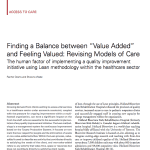
Thanks to the readers who sent this article my way and thanks to the authors for mentioning and citing my book, Lean Hospitals. The article “Finding a Balance between “Value Added” and Feeling Valued: Revising Models of Care, The human factor of implementing a quality improvement initiative using Lean methodology within the healthcare sector” appeared in the journal Healthcare Quarterly.
It's a relatively short article with a long title that didn't seem to match with the text of the article. The article describes some early Lean healthcare efforts in an Ontario children's rehab facility (Holland Bloorview Kids Rehabilitation Hospital) – efforts that seem to engage frontline staff in daily continuous improvement. That sounds like people are being valued while increasing the amount of time spent on value-added activity (such as direct patient care).
The piece describes the way the organization engaged staff members in improvement, as the article correctly identifies that Lean is a quality methodology (not just efficiency) and the two pillars:
Lean methodology is a management system for continuous quality improvement. It is based on the Toyota Production System that has as its focus two main themes: respect for all people and the elimination of waste or non-value-added activities.
The goals were patient and family focused, including:
- Improving access (reducing waiting times after referral)
- Improving the services offered to “clients” (their term for patient)
As they state:
To realize the true accomplishments that can be demonstrated through the implementation of Lean principles in a healthcare setting, one must look beyond the bottom line. The ability to reach an identified target and deliver on objectives relies on the successful engagement and empowerment of front-line staff, clients and families.
Respect for people was extended to include getting input from patients/clients and families as part of the Lean improvements.
The hospital started with Rapid Improvement Events (a more accurate term than “kaizen event”) but also moved on to daily “team huddles” for ongoing communication and improvement. Great stuff.
I appreciate the authors highlighting respect and engagement, as they wrote:
When individuals were treated with dignity and respect and valued for their contributions, and not simply as the occupant of a role, they were more likely to obtain a sense of meaningfulness from their interactions (Locke and Taylor 1990).
As a nurse said:
“Being a part of the discussion and, more importantly, the decision-making was what I found most rewarding about Lean. I now know that when I have an improvement idea, someone is there to listen and together as a team we can make the changes happen for the benefit of clients and families in our care.” (Katrine Pilested, registered nurse, Neuromotor Developmental Pediatric Outpatient Clinics)
It's best when staff members are directly involved in improving their own work – as Dr. Jack Billi from the University of Michigan discussed in his webinar, he wants 20,000 problem solvers making improvements every day. There's a time and a place for structured weeklong improvement events and there's a role for facilitators and consultants – but we won't improve very much if we always rely on experts. Holland Bloorview and their leaders seem to get that.
In their conclusion, the authors touch on the point alluded to in the title — but it's a point they didn't make directly in the piece itself:
In a healthcare setting where every action toward the care of a client comes from a place of best intention, one of the most significant hurdles to overcome is adopting Lean language. Specifically, understanding that an activity may be “valuable” but not necessarily “value-added” to a client can help one realize an opportunity for improvement.
The authors may be getting close to making the point that the term “value added” in a Lean framework can ruffle feathers and get people upset if we're not careful. You can likely use this Google Books link to read the page from my book Lean Hospitals where I start discussing these definitions.
Looking at a simplified case from a patient visit, we might have some steps including these:
- Being escorted a long distance by a volunteer from the parking lot to the registration desk
- Registering and filling out administrative / billing paperwork and medical history paperwork
- Waiting in the waiting room
- Being seen by the medical provider and receiving diagnosis, treatment, or education
Step 1: The walking would be considered the “waste of transportation” and is something we'd like to minimize given the chance to build a new facility (as they did with the outpatient center at Seattle Children's Hospital). This is not a value adding step. Now, if the volunteer is being friendly and helpful and bringing cheer or calm to the patient, this might be a nice thing… that aspect MIGHT be on the verge of being value… that's a grey area.
Step 2: This might be more of an issue in the U.S., but all of the insurance paperwork and forms… that's NOT value to the patient (remember that “value” is defined by the customer in Lean). Now, that paperwork is NECESSARY because the hospital and/or physician might need it to get paid. So, we can't stop doing it. It might be called “required waste” or some would call it “business value add,” but I don't care for that term. Filling out medical history paperwork might be value, if that information is used by providers downstream.
Step 3: Waiting is waste. We would strive to minimize this, to the best of our ability (again, something they've done well at Seattle Children's Bellevue).
Step 4: This is the value and why the patient is there…. that medical encounter.
Now, when we talk with hospital staff about the terms “value added” and “waste,” I always emphasize that we aren't passing judgement on them as people or as professionals. We all do things in our workday that are “waste.”
Let's say a person does nothing but register patients or do other work that we consider waste. We can still value the PERSON and work to reduce the waste. If we reduce waste and free up time, we have to find a way to redeploy that person. For nurses, we would want them to spend more time working with patients (and they would probably agree). For non-clinical staff, we have to find something other than layoffs – letting them move to another department, get retrained, etc. That's all part of the example Toyota sets with the “respect for people” principle. It's the right way to treat people and it's just good business. If people are afraid of layoffs, they're not going to participate in kaizen or continuous improvement activities.
So I think that was the point the article was trying to make – don't force changes on people and don't cast them aside or make them feel “not valued” even if they're doing “non value added” work.
What's your take on the article and/or my commentary? Leave a comment…
Please scroll down (or click) to post a comment. Connect with me on LinkedIn.
If you’re working to build a culture where people feel safe to speak up, solve problems, and improve every day, I’d be glad to help. Let’s talk about how to strengthen Psychological Safety and Continuous Improvement in your organization.









A bit late responding Mark, however, ‘short article with a long article’…am thinking you meant short article with a long title?
Knowing why you are waiting can be of value to the customer even if it may have elements of waste. While waiting for calibration of an excimer laser to meet standards for Lasik surgery, I had to wait. They came in and told me the steps they were taking. They told me every 5-8 minutes what was being done, what the back up plan was and why. Knowing why reduced my anxiety and I was ‘in the loop’ of the process. I appreciated having to wait. (They even offered juice, coffee and snacks a couple of times.) Would I recommend them, you bet.
Yes, I meant “long title.” Thanks for catching that (it’s now fixed).
I agree that being kept in the loop is helpful when waiting! We certainly don’t want to minimize waiting by skipping necessary steps, like machine calibration… the laser calibration might be consider value added (if it’s being set for a specific patient) or it’s possibly “necessary waste” (with the emphasis on the NECESSARY part of that phrase) if it’s routine calibration or if something had gone wrong with the laser that put it out of whack.
Comments are closed.